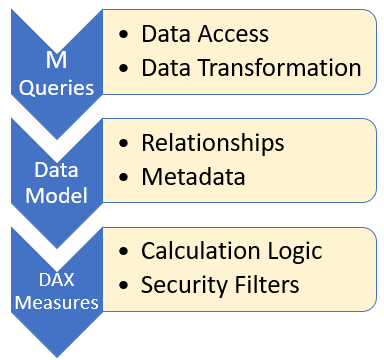As we saw in Chapter 7, Planning Power BI Projects, and Chapter 8, Connecting to Sources and Transforming Data with M, Power BI datasets are composed of three tightly integrated layers, all included within a Power BI Desktop file. The M Queries described in Chapter 8, Connecting to Sources and Transforming Data with M, connect to data sources and optionally apply data cleansing and transformation processes to this source data to support the Data Model. The Data Model, the subject of this chapter, concerns the relationships defined between fact and dimension tables, hierarchies of related columns, and metadata properties that define default behaviors, such as the sorting of column values. The final layer of datasets discussed in Chapter 10, Developing DAX Measures and Security Roles, Data Analysis Expressions (DAX) Measures, leverages the Data Model (and thus the M Queries) to deliver analytical insights for presentation in Power BI and other tools.
The following diagram summarizes the role of each of the three dataset layers:

At the Data Model layer, all data integration and transformations should be complete. For example, it should not be necessary to define data types or create additional columns at the Data Model level.